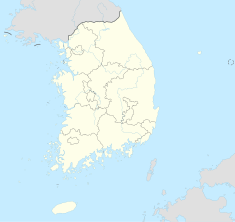Donggureung
| Donggureung | |
|---|---|
 Geonwolleung | |
| Location | 197 Donggureung-ro, Guri, Gyeonggi Province[1] |
| Coordinates | 37°37′21″N 127°07′55″E / 37.622608°N 127.132075°E |
| Area | 1,96 km²[1] |
| Governing body | Cultural Heritage Administration of Korea |
| Type | Cultural |
| Criteria | iii, iv, vi |
| Designated | 2009 (33rd session) |
| Reference no. | 1319 |
| Region | Asia and Australasia |
| Korean name | |
| Hangul | 동구릉 |
|---|---|
| Hanja | |
| Revised Romanization | Donggureung |
| McCune–Reischauer | Tongkurŭng |
Donggureung (lit. 'The Nine Eastern Royal Tombs'), is a cluster of royal tombs from the Joseon dynasty, the largest of its kind in South Korea. 17 Joseon kings and queens are buried here. The cluster also houses a myo-type tomb (of a royal family member). It is located in Guri, Gyeonggi Province.[1][2][3][4][5]
The construction was ordered by King Taejong in 1408 and the ninth tomb was placed there in 1855.[2]
List of tombs
| Tomb | Deceased | Year | |
|---|---|---|---|
| Geonwolleung (건원릉) | King Taejo | 1408 | |
| Mongneung (목릉) | King Seonjo Queen Uiin Queen Inmok |
1600 | |
| Hyeolleung (현릉) | King Munjong Queen Hyeondeok |
1452 | |
| Sureung (수릉) | Crown Prince Hyomyeong (posthumously King Ikjong) Queen Sinjeong |
1890 | |
| Hwireung (휘릉) | Queen Jangnyeol | 1688 | |
| Gyeongneung (경릉) | King Heonjong Queen Hyohyeon Queen Hyojeong |
1849 | |
| Wolleung (원릉) | King Yeongjo Queen Jeongsun |
1776 | |
| Hyereung (혜릉) | Queen Danui | 1718 | |
| Sungneung (숭릉) | King Hyeonjong Queen Myeongseong |
1674 | |
| Myeongbinmyo (명빈묘) | Royal Noble Consort Myeong of the Andong Kim clan (King Taejong's concubine) | 1479 | |
| Source: Cultural Heritage Administration[3] | |||
References
- ^ a b c "구리 동구릉 (九里 東九陵)" (in Korean). Cultural Heritage Administration. Retrieved 2015-11-25.
- ^ a b "East Nine Royal Tombs, Guri". Cultural Heritage Administration. Retrieved 2015-11-25.
- ^ a b "구리 동구릉" (in Korean). Cultural Heritage Administration. Retrieved 2016-01-05.
- ^ "Donggureung Royal Tomb [UNESCO World Heritage] (구리 동구릉 [유네스코 세계문화유산])". Korea Tourism Organization. Retrieved 2016-01-22.
- ^ Oh Hong-seok (2009). Traditional Korean Villages. The spirit of Korean cultural roots. Ewha Womans University Press. p. 68. ISBN 9788973007844.

